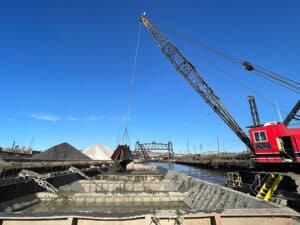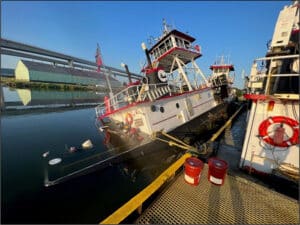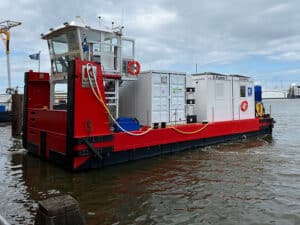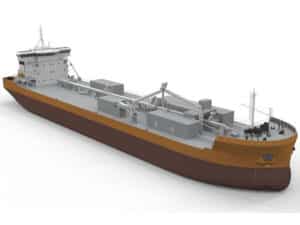
When rivers rise: developing a high-water action plan
Written by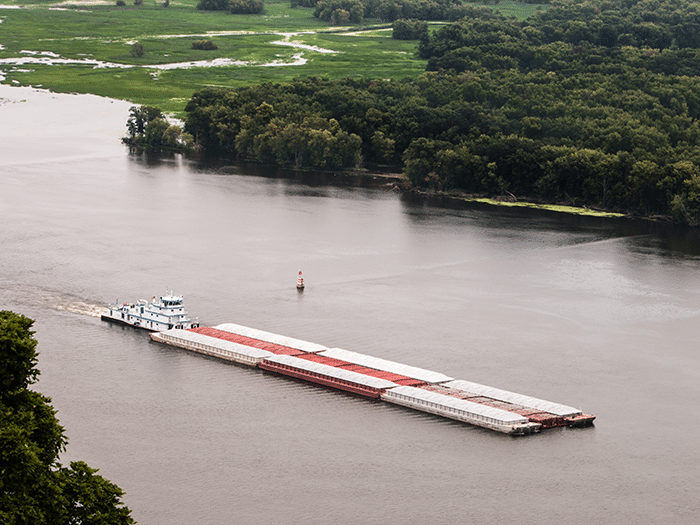
Both the size of the area impacted by high water, and the duration of high-water events, are growing. (Credit: Shutterstock/Kira Volkov)
By Michael Breslin, Director – Safety & Sustainability, American Waterways Operators
In less than eight months, the Mississippi River’s water levels have experienced significant fluctuations. In October 2022, the river reached unprecedented lows, followed by high water levels in April not recorded since 2001, as reported by the National Weather Service. These extreme weather events and operating conditions are becoming more frequent.
To effectively prepare, operators must thoroughly examine their policy, training, and communication strategies to ensure that their Towing Safety Management System (TSMS) remains up to date, accessible, and useful, regardless of the depth gauge readings.
It is evident that both the size of the area impacted by high water, and the duration of high-water events, are growing. For this reason, barge, and towing companies—even those operating in areas not traditionally impacted—should have procedures in their TSMS that consider flood risk. Your company’s high-water plan should provide clear and actionable assignments for operators, managers, and shoreside support teams.
An effective structure to follow is the one presented in the Coast Guard’s Waterways Action Plans, which use different water gauge levels as triggers for specific actions. The Waterways Action Plans are organized into three safety control categories: Watch, action, and recovery.
During the watch phase, organizations can prepare by implementing steps including:
- Delivering water, food, fuel, and stocking backup batteries, PPE, engine oil, fuel, and air filters;
- Staging parts and spares close to regional operations for easier access;
- Checking vessel and barge rigging conditions and ensuring spare face rigging, safety lines, barge wires, and tools are readily available;
- Considering limiting vessel fuel capacity to 75% to reduce draft and increase freeboard;
- Evaluating crew assignments to ensure experienced personnel are in key locations and fleeting areas;
- Setting policy to restrict or prohibit downstreaming activities in high-velocity river conditions; and
- Conducting training sessions, drills, and exercises to enhance preparedness and response capabilities.
When high water is imminent, you enter the action phase. This involves a stepped response that should follow Coast Guard-issued Marine Safety Information Bulletins (MSIBs). You may reference your local Waterways Action Plan for examples of actions and restrictions that may be implemented at each change in water level. As water levels rise, specific MSIBs will define actions that must be taken and sometimes reported to the Coast Guard. These MSIBs typically cover:
- Fleet size management and reduction;
- Additional harbor vessels on standby;
- Anchor requirements for ships;
- Restrictions on midstream operations;
- Enhanced Vessel Traffic Systems requirements, including increased communication with Traffic during system transits; and
- Closure of specific waterway sections when gauges reach flood stage.
In addition to following the Coast Guard’s requirements, organizations should take proactive steps to manage their workforce readiness, including:
- Communicating emergency numbers and key contact numbers to customers and employees;
- Sharing your plan with your vendors and customers to reduce miscommunications;
- Stopping large tows outside of danger areas, whenever possible, and rescheduling them to come in after the threat has passed;
- Checking rigging and putting out additional lines in fleets and on tows to add an extra level of protection against a breakaway;
- Checking all voids and watertight seals on vessels and barges and fixing leaks as necessary;
- Setting a regularly scheduled call with key personnel;
- Joining your Port Safety Coordination Call or participating in operational groups such as the River Industry Action Committee or the Lower Mississippi River Committee;
- Conducting weather updates for crews as often as needed to ensure fleet safety; and
- Staging spare fuel for water pumps and employee vehicles around crew change locations.
As the waters recede, the recovery stage begins, and it is important to then take stock of assets and personnel:
- Check in with mariners at home to identify and support those impacted by a flood event;
- Assess how crew change may be impacted due to road closures or areas with restricted access;
- Prepare plaques or ‘essential worker’ letters if needed for employees returning to work; and
- Consider that some mariners may have lost a vehicle to flooding and will require an alternate means of transportation to the boat.
Using this outline along with the resources in your local Waterways Action Plans, and engaging with industry groups and associations, will help your organization prepare. By planning for the worst-case scenario, communicating early and often with employees, and conducting training and drills to improve readiness, you will ensure your organization is able to navigate a rising tide of uncertainty and remain safe during the next high-water event.

